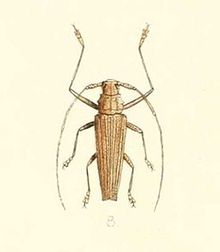
The Corpo Ausiliario delle Squadre d'azione di Camicie Nere, most widely known as the Black Brigades, was one of the Fascist paramilitary groups, organized and run by the Republican Fascist Party operating in the Italian Social Republic, during the final years of World War II, and after the signing of the Italian Armistice in 1943. They were officially led by Alessandro Pavolini, former Minister of Culture of the fascist era during the last years of the Kingdom of Italy.

Zaptié was the designation given to locally raised gendarmerie units in the Italian colonies of Tripolitania, Cyrenaica, Eritrea and Somaliland between 1889 and 1943.

Dubat was the designation given to members of the semi-regular armed bands employed by the Italian "Royal Corps of Colonial Troops" in Italian Somaliland from 1924 to 1941. The word dubat was derived from a Somali phrase meaning "white turban".

Oedipina uniformis is a species of salamander in the family Plethodontidae. It is found in mountains and lowlands of central Costa Rica to the Panamian border and likely to occur in Panama.

Nocardicin A is a monocyclic β-lactam antibiotic included in the monobactam subclass. It is obtained from the fermentation broth of a strain of actinomycetes Nocardia uniformis subsp. tsuyamenensis as a metabolic product catalyzed by the enzyme nocardicin-A epimerase. It is stereochemically and biologically related to penicillin and cephalosporins.

Lasionycta uniformis is a moth of the family Noctuidae. It is widely distributed in the mountains of western North America. It occurs from southern Yukon to northern California and Colorado, with an isolated population in eastern Quebec.

Cypa uniformis is a species of moth of the family Sphingidae. It is known from China, north-western India and Borneo.

The Royal Corps of Colonial Troops was a corps of the Italian Armed Forces, in which all the Italian colonial troops were grouped until the end of World War II in Africa.

Homonoeini is a tribe of longhorn beetles of the subfamily Lamiinae. It was described by James Thomson in 1864.

Homonoea is a genus of longhorn beetles of the subfamily Lamiinae, containing the following species:

Sceloporus uniformis, also known as the yellow-backed spiny lizard, is a reptile of the family Phrynosomatidae. It is native to the Mojave and Great Basin deserts. Until recently, it was considered to be a subspecies of Sceloporus magister.
Homonoea pannosa is a species of beetle in the family Cerambycidae. It was described by Edward Newman in 1842. It is known from the Philippines.
Homonoea praecisa is a species of beetle in the family Cerambycidae. It was described by Edward Newman in 1842. It is known from the Philippines and Borneo.
Homonoea albosignata is a species of beetle in the family Cerambycidae. It was described by Stephan von Breuning in 1950. It is known from the Philippines.
Homonoea boudanti is a species of beetle in the family Cerambycidae. It was described by Karl-Ernst Hüdepohl in 1995. It is known from the Philippines.
Homonoea flavescens is a species of beetle in the family Cerambycidae. It was described by Stephan von Breuning in 1958. It is known from the Philippines.
Homonoea ornamentalis is a species of beetle in the family Cerambycidae. It was described by Heller in 1926. It is known from the Philippines.
Homonoea rotundipennis is a species of beetle in the family Cerambycidae. It was described by Stephan von Breuning in 1950. It is known from the Philippines.
Homonoea samarana is a species of beetle in the family Cerambycidae. It was described by Heller in 1924. It is known from the Philippines.
The Military ranks of the Italian Social Republic were the military insignia used by the Italian Armed Forces of the Italian Social Republic. The ranks were essentially the same as the Military ranks of the Kingdom of Italy, however, with the symbols of the monarchy removed.









